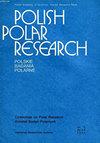雪作为北极冰川表面物质平衡组成部分的重要性(汉斯布林,斯匹次卑尔根南部)
IF 0.8
4区 地球科学
Q4 ECOLOGY
引用次数: 6
摘要
在极地环境中,融雪是淡水资源的重要组成部分。冰川排水系统供水的季节性波动影响冰川动力学,并间接影响峡湾的水循环和分层。本文研究了斯匹次卑尔根南部汉斯布林地区积雪融水产量的空间分布。我们估计了冰川上积雪的淡水量。作为一个案例研究,我们用2014年作为21世纪最温暖的季节之一。利用高频探地雷达在最大积雪阶段附近测量积雪深度。同时,对不同冰川高程带3个雪坑的积雪结构及其物理性质进行了分析。结合这些数据构建了整个冰川的雪密度模型,该模型与雪深分布是估算冰川冬季物质平衡的重要参数。利用平均温度递减率和地表高程变化,采用温度指数模型计算积雪消融。应用高度日因子,我们估计平均日消融速率在0.023 m d -1°C -1(消融区)和0.027 m d -1°C -1(堆积区)之间。冰川参考点的直接消融数据进一步证实了这一融化速度。2014年消融季融雪日平均出水量为0.0065 m w.e.(水当量),淡水总量为41.52·10.6 m³。消融量占积雪冬季累计水量的85.5%。2014年6月和9月极端日融雪量超过0.020 m w.e, 7月6日最大(0.027 m w.e)。消融季结束时,汉山75.8%的地表积雪完全消失。本文章由计算机程序翻译,如有差异,请以英文原文为准。
Importance of snow as component of surface mass balance of Arctic glacier (Hansbreen, southern Spitsbergen)
: Snowmelt is a very important component of freshwater resources in the polar environment. Seasonal fluctuations in the water supply to glacial drainage systems influence glacier dynamics and indirectly affect water circulation and stratification in fjords. Here, we present spatial distribution of the meltwater production from the snow cover on Hansbreen in southern Spitsbergen. We estimated the volume of freshwater coming from snow deposited over this glacier. As a case study, we used 2014 being one of the warmest season in the 21 st century. The depth of snow cover was measured using a high frequency Ground Penetrating Radar close to the maximum stage of accumulation. Simultaneously, a series of studies were conducted to analyse the structure of the snowpack and its physical properties in three snow pits in different glacier elevation zones. These data were combined to construct a snow density model for the entire glacier, which together with snow depth distribution represents essential parameters to estimate glacier winter mass balance. A temperature index model was used to calculate snow ablation, applying an average temperature lapse rate and surface elevation changes. Applying variable with altitude degree day factor, we estimated an average daily rate of ablation between 0.023 m d -1 °C -1 (for the ablation zone) and 0.027 m d -1 °C -1 (in accumulation zone). This melting rate was further validated by direct ablation data at reference sites on the glacier. An average daily water production by snowmelt in 2014 ablation season was 0.0065 m w.e. (water equivalent) and 41.52·10 6 m 3 of freshwater in total. This ablation concerned 85.5% of the total water accumulated during winter in snow cover. Extreme daily melting exceeded 0.020 m w.e. in June and September 2014 with a maximum on 6 th July 2014 (0.027 m w.e.). The snow cover has completely disappeared at the end of ablation season on 75.8% of the surface of Hansbreen.
求助全文
通过发布文献求助,成功后即可免费获取论文全文。
去求助
来源期刊

Polish Polar Research
ECOLOGY-GEOSCIENCES, MULTIDISCIPLINARY
CiteScore
2.00
自引率
7.70%
发文量
0
审稿时长
>12 weeks
期刊介绍:
The quarterly Polish Polar Research edited by the Committee on Polar Research of the Polish Academy of Sciences is an international journal publishing original research articles presenting the results of studies carried out in polar regions.
All papers are peer-reviewed and published in English.
The Editorial Advisory Board includes renowned scientist from Poland and from abroad.
 求助内容:
求助内容: 应助结果提醒方式:
应助结果提醒方式:


